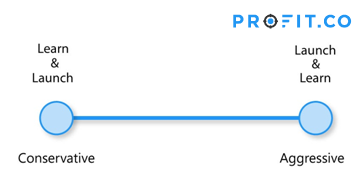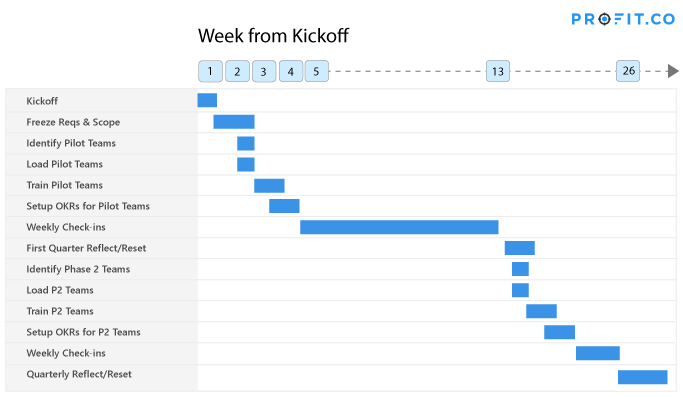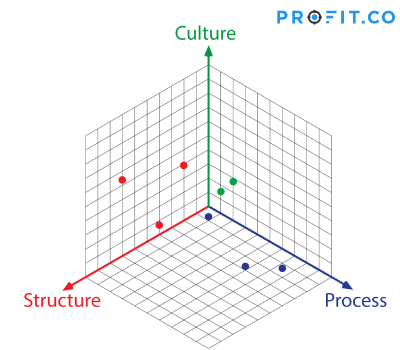The best way to get started with your OKR program is to actually get started. You will have different combinations of culture, style, processes, and values that makes the DNA of every business or organization unique.
You don’t have to be great to start, but you have to start to be great.
There is a whole spectrum of possibilities on where and how to get started. At the conservative end of this spectrum, you’ll find businesses who want to be pretty thorough, pretty comfortable before they actually put their OKRs on paper. At the aggressive end of this spectrum, you’ll find businesses just want to jump into the pool and learn along the way.

In reality, you’ll find yourselves somewhere in between. Based on your unique DNA, you can prepare yourself through reading exercises, knowledge sharing sessions, conversations, meetings, and external training sessions to plan how to get started with OKRs. But it’s important to just get started.
The other, more important idea to keep in mind is that the process of adopting OKRs itself has to be iterative. You will not get it right in the first quarter. But you’ll start getting the hang of things. You will see many of the twenty red flags across the four phases of the PEEL cycle. You will always learn something new every quarter and as long as you institutionalize this learning and incorporate that learning into the next OKR cycle, you are well on your way to having a very successful OKR program.
OKRs are not tasks
OKRs are not tasks where you can simply mark them as done and move on. There is an interconnectedness to what you do in OKRs and hence there is a certain amount of effort to ensure that the right OKRs are set, tracked and achieved to ensure that you are doing the right things organizationally. While a task is simply done by an individual, OKR is really a methodology or system for the entire company.

With that background that OKRs are not simple, we would still say “just get started.” Now, getting started doesn’t mean you roll out OKRs to all the 50, 100, or 1,000 people in your organization on day one, where they all are going to sit and write their OKRs in one day. But just start rolling by identifying a small pilot team and getting them started with their key initiatives modeled and practiced through OKRs. The pilot team can either be:
- A department or sub-department. Top to bottom, all the way from the head of the department to every individual in the department, are included on that pilot team.
- Top management layer. From the CEO or some C level executive and their next level, which is usually a set of VPs. And sometimes the director level is also included.
Take either approach and start setting up OKRs, checking in, conducting meetings, reviews and get a feel for the structure and process of OKRs, to see how things pan out.
Your company’s OKR program is unique to you
Just keep an open mind, and you will learn lots of new things. You will know what works, and what doesn’t work for your business. Your uniquely signed OKR program can be placed in a space across 3 angles — Culture, Structure and Process.

Structure
Structure refers to both the Organizational structure and how your organization decides to practice OKRs. You can practice OKRs at the corporate and department levels and sometimes go deeper to individual levels. In other cases, OKRs are set at individual levels only. If you do practice OKRs at the department level, then how your departments are structured makes up the “structure” aspect of your OKR program.
Process
Process refers to the OKR process itself. Planning, weekly reviews, in quarter adjustments, end of quarter reviews and everything in between. There are various aspects to getting your process designed right including what review process you are going to adopt and use.
Culture
Your OKR program will be heavily influenced by your organizational culture. It goes without saying that the culture of the organization is created and shaped by the people who are in senior leadership roles.
Great OKR programs provide competitive advantage
While OKRs are thought to be rigid in structure and process, they actually are not. If OKRs are standardized and can be reduced to a set of standard practices that every company can just adopt and use, it can’t be a competitive advantage. In our opinion, good OKR programs in every company can be a competitive advantage for them in their own way.
Since you have to find your own unique OKR DNA, you have to iterate a few quarters to find your unique sweet spot. If you understand this conceptually, you will be able to steadily make progress towards your ideal OKR position.
Top reasons for postponing OKRs
While we are advocating you to get started with OKRs here, we will also tell you the most common reasons that you will hear when you want to get going with OKRs.
Don’t have enough time for OKRs
Mark Cuban says he worries about the ROT, or the return on (his) time, when he looks for investment, not just ROI. You never find yourself in a situation where you have a lot of time and very little things to do. Almost never. However standard it is, “don’t have time” is the worst possible excuse for not going ahead with OKRs.
My Yoga teacher says this. Don’t tell me you can’t do Yoga because your body is not flexible. You do Yoga to get your body to become flexible. So, you don’t give the reason that you cannot get OKRs going because you do not have enough time. You start OKRs to manage your time more effectively and efficiently. It’s that simple.
Need to get trained on the standard process
As we discussed earlier, the biggest misconception with OKR rollouts is to think & believe that there is a standardized template to adopting OKRs. Know this — there is no standard template. Many such templates start with “Read a book”.
It’s good to have a good understanding of OKRs, but that shouldn’t be taking a quarter of reading a few books and researching. You can actually get this going within a few weeks.
Need to get a good consultant to guide us
Finding a reputed consultant and having them coach you before you can get going with OKRs is great. A great OKR consultant will not teach you the structural and process aspects of OKRs and help you find your own unique OKR position that fits the best elements of their structure and process into your culture.
Many times you cannot really afford a 3-6 month long implementation cycle both in terms of money and time. There are many consultants who offer 5-hour courses and certifications at a DIY pace. So, while there is nothing wrong in getting someone to guide you, that need not be a precondition.
Need to get a good software tool
Many think that you have to get an OKR software tool before you can get going. Software tools can be helpful, but they’re definitely not a prerequisite. The idea of buying a software before you can get your OKR program going, is not necessarily true. If you’ve been managing your OKRs using spreadsheets for a quarter or two, you will get a lot of benefits by switching to a software.
While a good software tool will also provide some education and also can help you enforce some good habits in your OKR DNA, it is not a prerequisite.
Many consultants might actually tell you to get going with spreadsheets or PowerPoint. There’s nothing wrong with that. Like we’ve been saying, “getting started is important.” If one or more of the perceived prerequisites are not there, you should define a smaller scope and get going. We just don’t like “waiting”.
OKR Quick Start Guide
With the background provided thus far, we’ll give you a quick to do list to get started:
- Establish pilot team
- Plan 3-5 OKRs for the pilot team members
- Keep alignments simple
- Incorporate OKR check-ins into your weekly schedule
- Remove roadblocks to achieving the key results you set out to achieve regularly.
- Communicate change in priorities, plans effectively and immediately.
- Document learning regularly.
- Reflect/reset at the end of the quarter.
This list is deceptively simple and it is intended to be. There is a lot of online material that covers these steps in detail. And most of them can be done using simple tools. This simple list is enough to get started.
You can get great consultants and software to help you along this process. But don’t make them a necessary condition to get started.

